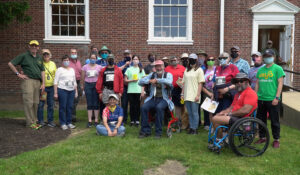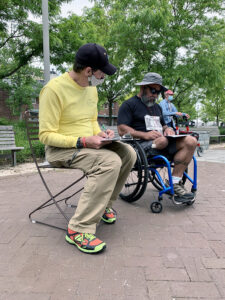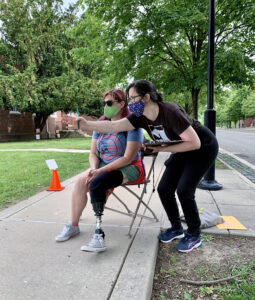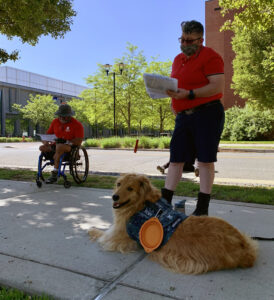New land navigation championship format showcases accuracy and inclusivity for all
What sport can you do for only the cost of a compass?
In trail orienteering, or Trail-O, athletes use true North in navigating a contour map featuring a certain number of control stations along a predetermined course. Their timed task is to look at how a station is set up and mark down which of several flags is in the correct spot using a set of clues.

The 2021 Orienteering USA (OUSA) Veteran Paralympic Trail Orienteering National Championships hosted by the Capital Region Nordic Alliance (CRNA) and the Four Chaplains Memorial Foundation presented its challenges on the grounds of the historic Chapel of the Four Chaplains in the Philadelphia Navy Shipyard May 15-16.

The goal of its competition was to introduce newcomers to the sport while allowing seasoned competitors to experience it in an adaptive way. The reason it was not held in a traditional, rural setting that typically includes cliffs, boulders and streams was so those experiencing mobility and cognitive impairments could compete on more equal terms.
CRNA (Albany, N.Y.) is a Move United chapter that sponsors its Paralympic athletes in cross-country skiing, biathlon, skeleton and bobsled year-round. It added orienteering, which is similar to land navigation in the military, to its Nordic menu after receiving a Department of Veterans Affairs (VA) adaptive sports grant.
Executive Director Russ Myer said having veteran Paralympic participants in these first championships since the onset of the novel coronavirus (COVID-19) is rare, but a plus for the sport.
“We see so much good that comes from their involvement,” said Myer.
Miko Latva-Kocco was crowned overall champion in the weekend’s Open class (non-Paralympic) and said growing up in Finland, he started orienteering in elementary school, when his town took part in it. OUSA President Clare Durand said people in the United States come to Trail-O seeking something less physical, but still demanding.
International Orienteering Federation (IOF) competitor and 75th Army Ranger Battalion veteran Julius Schram (Los Angeles) is an amputee athlete in another championship discipline of orienteering called foot orienteering, but he competed in the CRNA Trail-O event using his wheelchair. He is also a para biathlete and said there are similarities.
“Both orienteering and biathlon have intensity and challenges, but the environment is easy-going,” said Schram, who competed in the 2018 World Championships in the Trail-O event in Latvia.
Maps and More Maps
In a trail orienteering competition, map legends consist of standardized symbols for the prominent features around the locations of the controls at each race station. Its two formats are Pre-O (precision orienteering) and Temp-O (short form), where individuals are presented with timed questions from an official. The only difference on day two is that there are more choices and a “dummy” flag with which to contend.
At the Navy yard, both events were held in a landscaped, urban setting.
On day one, competitors tackled puzzles at 18 stations set inside the 5-acre public park called Central Green, which incorporated a running track, bocce and tennis courts, an outdoor amphitheater and a sun lawn. Each person carried a timing card, which showed where he or she had been on the path based on a number of punches made.
Bobby Camp is an Air Force veteran from Rhode Island who sustained a traumatic brain injury.
“[Orienteering] is a way to exercise and sharpen certain skills that have diminished due to my injuries. It might not be long-term, but it gives them a fluffing up,” he said.

The maximum time limit for a Pre-O course is 80 minutes for the Open class and 100 minutes for a Paralympic class, not including 90-second timed control sessions at the start and finish in case of a tie.
David Irving (San Diego, Calif.) was bronze medalist at the 1999 World Cup and took top prize in the Paralympic class in Philadelphia.
“The trick is, if you make a mistake, to go on. If you think about it through the next station, it will slow you down and slow means inaccurate,” Irving said.
Air Force veteran and para skeleton athlete Lee Kuxhaus was pleased with her second-place Pre-O finish with nine out of 18 points and had fun competing alongside her husband, former Department of Defense civilian, Jonathan.
“This is all new to me,” she said. “On the ice, I do not have two-and-a-half minutes to think. Skeleton is over in about 54 seconds.”
Navy veteran Rhonda Liddell did better than 50% on her first outing in her first Trail-O in two years, finishing in second place in Pre-O and third in Temp-O with her support canine, Remy, by her side. She practiced using CRNA’s Microsoft Soundscape virtual Trail-O courses.
“Adaptive sports has been what I needed to feel like a whole person again,” she said. “Where else can I hang out with such a good caliber of people – and have a chance to make a U.S. team?”
A Community of Veterans
Bill Kaemmer is the executive director of The Four Chaplains Memorial Foundation that hosted the Trail-O Championships with CRNA.
”What makes it neat to have the event at the Navy yard is that for those who served, it feels like home,” he said.
Durand, who is serving her second term as president of OUSA, said there have been a couple of foot orienteering events in the last month among its 60 clubs, but orienteering is getting going again at the national ranking levels since the pandemic.

Results from this event will count towards qualifying for the World Cup to be held in Jelenia Góra, Poland, which has been postponed until June 19-23, 2022. Durand’s goal is to bring that championship to home soil in 2025.
Regardless of rankings, Kuxhaus said when she gets together with other disabled veterans, she realizes everybody has walked a different path.
“We might do this course by ourselves, but in Trail-O, around the world, there is a whole community available to us,” she said.
Get the final results of this year’s championships here.
For information: www.orienteeringusa.org and www.capitalregionnordicalliance.org.